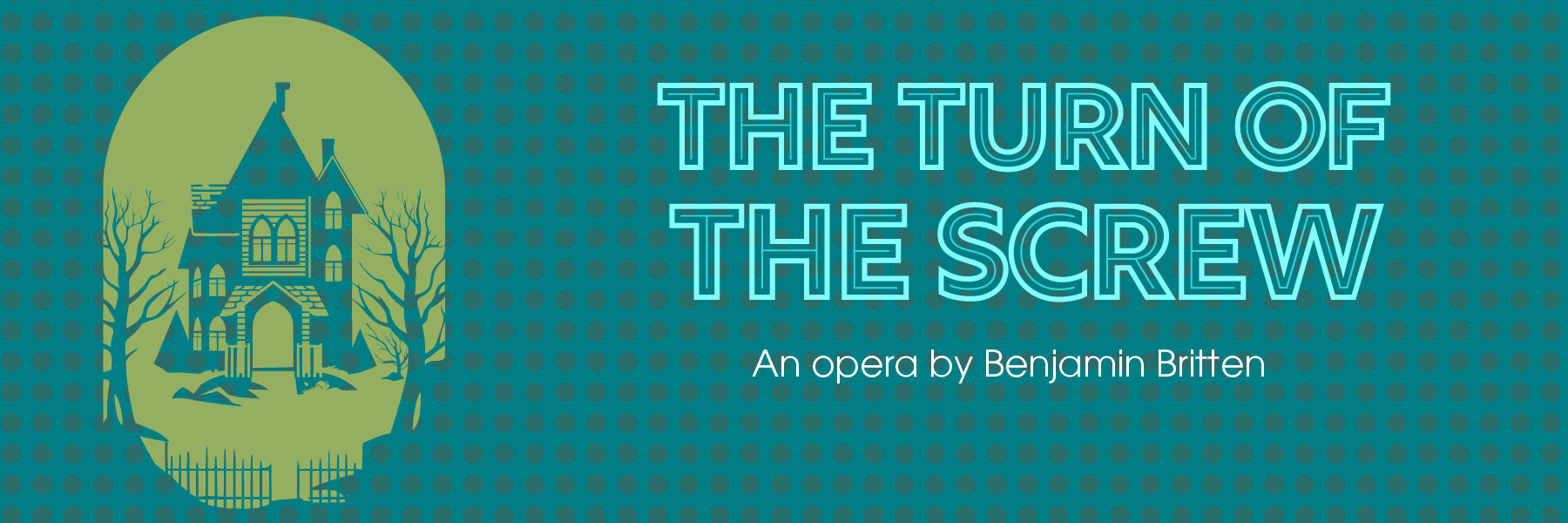by Allan Armstrong
Setting: In and around Bly, a country house in the East of England
Time: The mid-1800s
Act I
Prologue
The Prologue introduces a curious account of a Governess. She goes to London and meets with a man who is the only surviving relative (uncle) to two children. He hires her to replace a governess who had gone away and charges her to be responsible for everything. Under no circumstances is she to contact him. Dazzled by the handsome young man, the young woman accepts, despite being full of doubts.
The Journey
In a brief interlude, we are introduced to the “screw theme” in the orchestra. This is the musical foundation that will permeate the rest of the opera. The theme is a 12-tone row but treated in a tonal fashion. We experience the Governess traveling by coach to the country house of Bly, where the two children live with an old housekeeper. She expresses trepidation about the isolated nature of the job she is undertaking. The Governess steels herself, saying, “Be brave. We’re nearly there. Very soon I shall know . . . .”
The Welcome
The scene opens in the country house of Bly. The two children, Miles and Flora, excitedly pepper the housekeeper, Mrs. Grose, with questions about the new Governess as they await her imminent arrival. Mrs. Grose tries to coach the children on how to bow and curtsey. Upon first meeting her charges, the Governess is entranced by how charming they seem. Mrs. Grose expresses relief that she will have some assistance with the children, and the scene ends with the Governess singing, “For Bly is now my home.”
The Letter
The happiness of the Governess is short lived, as a letter arrives revealing that Miles has been dismissed from boarding school over some unspecified injury to his friends. The Governess and Mrs. Grose discuss this information and decide not to contact the uncle in London. Throughout the scene, Flora and Miles can be heard singing a nursery song.
The Tower
The Governess is enjoying a summer evening stroll outside the house. She talks about her “first fluttering fears” dissipating as she feels now at home. Her reverie is interrupted by the appearance of an unknown man on the tower of the house. She is thrown into agitation, wondering who this stranger could be and what malign motives he might have.
The Window
Flora and Miles play a game and sing a children’s song. After they depart, the Governess again spots the strange man, this time looking through a window. Mrs. Grose enters and notices the frightened state of the Governess. The Governess tells of seeing this stranger and minutely describes his appearance. Mrs. Grose, with great emotion, identifies him as Peter Quint, the former valet. At the prompting of the Governess, Mrs. Grose explains that Quint was “free” with everyone, including the children and the lovely previous governess, Miss Jessel. Both Miss Jessel and Peter Quint have died, by an unspecified cause for Miss Jessel and by a fall on an icy road for Quint. The Governess immediately thinks that Quint has returned in search of Miles. She vows to protect the children and, once again, not to contact the uncle in London.
The Lesson
The children are reciting Latin and British history. The Governess praises Miles’ Latin and asks what else he remembers. He sings an unsettling aria involving the triple meaning of the word “Malo”: to prefer, a type of apple, and bad.
The Lake
Flora and the Governess are walking by a lake outside the house. Flora sings a lullaby to her doll as the Governess spots the ghostly figure of Miss Jessel across the lake. The Governess is terrified and runs to find Miles. She laments that she is powerless to protect the children, “They are lost!” At night, Quint calls Miles’ name in the darkness. He entices him with fanciful nocturnal images of a magical hidden life. Miss Jessel calls to Flora, and both children are entranced. The Governess and Mrs. Grose arrive to find the children outside in the night. Miles closes the act by saying, “You see, I am bad.”
Act II
Colloquy and Soliloquy
As the Governess sleeps, Quint and Miss Jessel describe a plan to possess the children. The climax of their conversation is a line from a poem by W. B. Yeats, “The ceremony of innocence is drowned.” The Governess awakes in a panic, feeling isolated and without a course of action.
The Bells
Flora and Miles sing increasingly distressing parodies of church music as they walk to Sunday service. Mrs. Grose happily prattles on about the weather and the sound of the bells while the Governess becomes increasingly terrified of the children. The Governess feels challenged by Miles and flees from the church.
Miss Jessel
The Governess finds Miss Jessel sitting in the schoolroom. Miss Jessel explains that here is where her tragedy began, and here is where revenge begins. She is implacable about her efforts to possess Flora. The Governess drives her away and becomes convinced that she must finally write to the far-off uncle. She composes a letter and begs his forgiveness.
The Bedroom
The Governess confronts Miles in his bedroom by candlelight. She tells him about the letter, and their conversation is interrupted by the distant calls of Quint. In a terror, Miles shrieks, and the candle is extinguished.
Quint
Peter Quint convinces Miles to steal the letter from the desk.
The Piano
Miles practices the piano while Flora plays at “cat’s cradle.” The Governess and Mrs. Grose outwardly marvel at the children while in a hushed aside, the Governess reveals that she has written a letter to the uncle. Mrs. Grose dozes off, and while the Governess is distracted by Miles at the piano, Flora sneaks out of the house. The scene ends in a panicked search for the young girl.
Flora
Flora is discovered outside and is questioned by the Governess about Miss Jessel. Flora explains that she now hates the Governess, and Miss Jessel appears in the distance calling for Flora.
Miles
Mrs. Grose explains that she must take the severely disturbed Flora away from Bly. The Governess expresses relief that her letter to the uncle must have arrived by now. Mrs. Grose quietly relates that the letter was never sent because it couldn’t be found. The Governess goes to confront Miles, who she now knows has taken the letter. The Governess forces Miles to confess to the theft as Quint appears to Miles and tries to warn him about the Governess. Quint bids Miles to be silent while the Governess demands that Miles say the name of the ghostly character. Miles finally says the name of Peter Quint and falls lifeless to the ground. Quint vanishes, and the Governess repeats “Malo, malo” in a state of shock.
by Michael Shell
When I directed The Turn of the Screw for the Jacobs School of Music 2020-21 season, the fear of the unknown was highly palpable. The thought of what could be lurking around the corner, a sudden dry cough, runny nose, loss of taste or smell, and other symptoms of COVID-19 was a constant threat. At the beginning of that academic year, Jacobs, like other schools worldwide, was venturing into the unknown. Thanks to a large tent in a parking lot, the glorious stage at the Musical Arts Center, an adventurous lighting and projection designer, and a determined and creative scenic designer, we jumped into the unknown to create five productions that year.
The fear of what those productions could look like due to the COVID-19 protocols of singers wearing masks and maintaining 10 feet of distance from each other at all times kept us from streaming the first two. However, after the first production that year, Mark Adamo’s Little Women, opened, it was clear to the tiny audience that these productions should and needed to be seen by audiences hungry for performances. In this case, the fear of lack of artistic quality up to Jacobs’ standards was unfounded.
Fear can bring the strongest of humans to their knees. Fear can be debilitating, causing one to stand still and be uncertain about where to turn next. Fear can also spur someone to jump into action, as it does to the Governess in our story. She boldly chooses to be the shero and save the children from an unknown evil. She is confident that this evil has manifested in the sightings of two ghosts: the former governess, Miss Jessel, and the former valet, Peter Quint. And to her, it is confirmed by Mrs. Grose, the housekeeper, who, through a vague recollection of events, excites the Governess’s fear of what may have happened in the past and could be happening now to her current charges, the 10-year-old Miles and the young Flora.
But what did happen to the children? Was their “innocence drowned,” as we hear Miss Jessel and Peter Quint exclaim in Act II? Is something wicked happening at the house called Bly, or is it just a manifestation of the fear of a very innocent woman trying to take charge of a situation that challenges her beyond her experience? The brilliance of the opera lies in these unanswered questions. The fear of what you don’t know and what isn’t spoken is sometimes the most horrifying of all.
We are so happy to share this production with a live audience this season. I would be remiss if I didn’t take this opportunity to thank my theater partners Mark Smith and Ken Phillips for being so willing to mine as much as we could out of the very little we had to work with during that first year. I will always be grateful to you both for being a bright light during a very dark and fearful time.
by Sarah Sabol
Ph.D. Student in Musicology
In a review of Henry James’ The Turn of the Screw, a reporter from The Independent wrote in January 1899 that “The Turn of the Screw is the most hopelessly evil story that we could have ever read in any literature, ancient or modern. How Mr. James could, or how any man or woman could, choose to make such a study of infernal human debauchery, for it is nothing else, is unaccountable.” Other reviews of James’ novella, which was first published episodically in the American magazine Collier’s Weekly in 1898, emphasized the story’s power and divergence from the conventional ghost story. One reviewer proposed the possible insanity of the governess, who acts as the primary narrator, and drew connections between this character and an unreliable narrator from James’ In the Cage, also published in 1898.
James’ The Turn of the Screw merges elements from Freudian psychology, clinical accounts of spirits, and the Victorian ghost story. His immediate family could have provided inspiration, as his sister, Alice, suffered from psychosis, and his brother William James, a psychologist and philosopher, was undoubtedly familiar with the works of Freud, who, in Studien über Hysterie (1895), had recounted an episode of a troubled governess who fell in love with her employer. A secondary interest of William’s was ghosts, and he was a member of the Society for Psychical Research. Henry James sometimes attended meetings, allowing him familiarity with scientific reports of apparitions.
The varied sources of potential inspiration signal two possible interpretations of James’ short story: 1) the ghosts of Peter Quint and Miss Jessel are real, or 2) the ghosts are a product of the governess’s deluded imagination. These readings change the face of evil. Either Quint and Miss Jessel terrorize the children as specters after corrupting them during their lives, or the hallucinating governess torments Flora and Miles, eventually driving one mad and smothering the other.
Benjamin Britten and his librettist, Myfanwy Piper, adapted this ambiguous short story after receiving a commission from the International Festival of Contemporary Music in 1952 in preparation for the 1954 season at the Teatro la Fenice in Venice. Britten, troubled by shoulder issues, delayed composing this work until March 1954, finishing at the beginning of August, a mere four months later. This chamber opera, a reflection of post-war economic constraints, calls for six singers and 13 instrumentalists. The work was premiered by the English Opera Group, an ensemble for which Britten frequently composed, with the composer conducting. Britten’s longtime romantic partner, Peter Pears, sang the role of the narrator in the Prologue and also that of Peter Quint.
James’ short story begins with a party scene, in which Douglas, a guest, describes his connections with his sister’s former governess and titillates his audience with the promise of a ghost story, finally reading her written account of these chilling events. Douglas repeats to his companions three times that they will “easily judge” the governess’s narrative, imbuing the ghost story with a clinical feel in which evidence is presented by a witness and evaluated by judges. Britten’s reduced ensemble did not have enough singers to enact the party scene that opens James’ work, so Douglas’s role is given to the Prologue’s narrator, who briefly sets the scene, omitting the lines about judgment. However, the party scene is retained; the audience members become the party guests, the judges, charged with weighing evidence and choosing an interpretation.
Britten’s music assists in elucidating his understanding of the tale. Britten undergirds the work with a 12-tone “Screw” theme, first heard at the end of the Prologue, from which nearly all musical motives are derived. This theme saturates the scenes, which are separated by 15 variations on the “Screw” theme. The variations contribute to the sense of timelessness between episodes; many of these reuse material from the previous scene and prepare the audience for the ensuing one. Britten uses themes derived from the “Screw” theme to musically link together characters. For example, Quint and the governess frequently use similar musical material, intimating that perhaps they are not so different. They share a battleground—Miles—and, depending on the interpretation, both could be viewed as corrupting him.
Quint and the governess struggle over who will possess the children and provide knowledge of the adult world. In Act 2, Scene 1, Quint and Miss Jessel describe their longing for the children, closing their petitions with “The ceremony of innocence is drowned,” a line borrowed from William Butler Yeats’s “The Second Coming,” which was written in 1919. The first stanza reads:
Turning and turning in the widening gyre
The falcon cannot hear the falconer;
Things fall apart; the centre cannot hold;
Mere anarchy is loosed upon the world,
The blood-dimmed tide is loosed, and everywhere
The ceremony of innocence is drowned;
The best lack all conviction, while the worst
Are full of passionate intensity.
Yeats’s lines depict a fallen world in which the worst players exert the most influence, and this “passionate intensity” accurately describes the exertions of the governess and Quint as they fight for control of the children. The “Screw” theme provides the material for Quint’s inflamed, seductive melismas on Miles’ name as he summons him in Act 1, Scene 8, and for the final scene, in which the governess sings “O Miles, I cannot bear to lose you. You shall be mine, and I shall save you,” before terrifying and suffocating him in a fit of passion.
Both James and Britten ask their readers and listeners to participate, acting as party guests and judges. James forces us to engage even more deeply; in his 1908 Preface to The Turn of the Screw, he wrote, “Only make the reader’s general vision of evil intense enough . . . and his own experience, his own imagination, his own sympathy (with the children) and horror (of their false friends) will supply him quite sufficiently with all the particulars. Make him think the evil, make him think it for himself, and you are released from weak specifications.” In this eerie tale, the past actions of Quint and Miss Jessel are never made explicit, which not only allows the possibility of two interpretations, but also pushes the reader to furnish a plausible scenario of past events at Bly. In Britten’s unsettling adaptation, Mrs. Grose, the housekeeper, only claims that “Quint was free with everyone,” and the governess leaps to conclusions about Peter Quint, condemning him as “spoiled, impudent, depraved.” We, the audience, also must form our own speculations after imagining the omitted evil or innocent acts, thus engaging with our deepest horrors.























